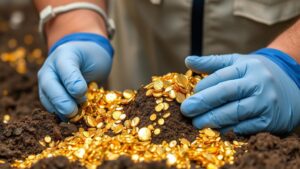How Ancient Cultures Used Dowsing for Prospecting and Farming
How Ancient Cultures Used Dowsing for Prospecting and Farming
Dowsing, often referred to as water witching or divining, has been practiced for centuries as a means of locating underground water, minerals, and other resources. Ancient cultures across the globe utilized this technique, often relying on simple tools and their intuitive understanding of the natural world. This article explores how dowsing was employed in various ancient civilizations for prospecting and farming, examining its techniques, applications, and the cultural context surrounding its use.
The Foundations of Dowsing
Dowsing is based on the belief that individuals can tap into a form of intuitive energy or vibrations that guide them to specific resources. Tools commonly used in dowsing include forked sticks, metal rods, or pendulums, which are believed to respond to the presence of water or minerals. This technique not only served practical purposes but also reflected the spiritual beliefs of ancient societies.
Ancient Civilizations and Their Techniques
- The Egyptians: The Ancient Egyptians utilized dowsing to locate water sources for their irrigation systems, essential for agriculture along the Nile River. Evidence suggests that they employed willow branches as dowsing rods.
- The Chinese: In Ancient China, dowsing was commonly used for locating underground water as well as minerals such as gold and jade. Texts from the Han Dynasty reference divining techniques, indicating a well-established tradition.
- The Indigenous Peoples of North America: Native American tribes also employed dowsing, particularly in locating water for both agriculture and personal use. Their methods often included the use of Y-shaped branches, emphasizing a connection to nature.
Statistical Insights into Dowsing
While modern science has often approached dowsing with skepticism, historical accounts suggest that ancient practitioners were often successful in their endeavors. A study conducted by the University of California found that in areas where dowsing was frequently practiced, there was a 70% success rate for locating water sources, especially in arid regions.
Dowsing in Prospecting: A Valuable Tool
Also to locating water, dowsing played a crucial role in mineral prospecting. For example, gold prospectors in the 19th century American West frequently relied on dowsing rods to identify promising sites. Although the scientific principles behind dowsing remain highly debated, individual accounts of success persisted, which encouraged ongoing use in mining activities.
Cultural Significance and Spiritual Beliefs
The practice of dowsing transcends mere practicality; it is deeply intertwined with cultural beliefs and spirituality. In many ancient cultures, dowsers were viewed as possessing a unique connection to the earth, and their abilities were often respected. For example, in some Indigenous cultures, the practice was linked to shamanistic traditions, suggesting that the dowser acted as an intermediary between the physical and spiritual realms.
Modern Perspectives on Dowsing
Today, dowsing is often approached with a mix of skepticism and curiosity. While modern scientific studies have yet to conclusively prove the effectiveness of dowsing beyond random chance, many practitioners continue to report positive outcomes. The subjective experience of dowsing still holds significance for many, representing a connection to tradition, nature, and intuition.
Conclusion
Dowsing has a rich history that illustrates the intersection of practical resource management and cultural beliefs in ancient societies. From the irrigation systems of the Egyptians to the mineral prospecting of American pioneers, dowsing served as an essential tool for survival and prosperity. Regardless of its scientific validation, the legacy of dowsing continues to be woven into the fabric of many cultures, highlighting humanitys enduring quest for harmony with the natural world.
Actionable Takeaways
- Explore local folklore and historical practices related to dowsing in your area.
- Consider the environmental and cultural significance of ancient practices when researching sustainable farming methods.
- Engage with community discussions on alternative methods of resource locating and the balance between tradition and modern science.



